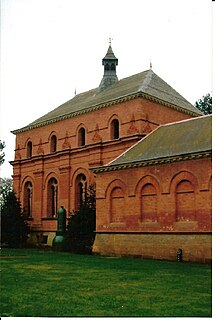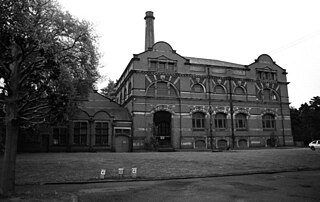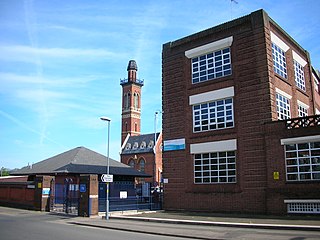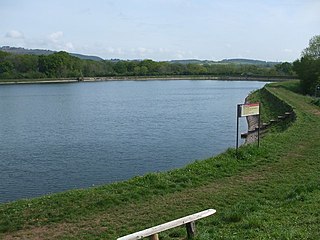
A water tower is an elevated structure supporting a water tank constructed at a height sufficient to pressurize a distribution system for potable water, and to provide emergency storage for fire protection. Water towers often operate in conjunction with underground or surface service reservoirs, which store treated water close to where it will be used. Other types of water towers may only store raw (non-potable) water for fire protection or industrial purposes, and may not necessarily be connected to a public water supply.

The Abbey Pumping Station is a museum of science and technology in Leicester, England, on Corporation Road, next to the National Space Centre. With four working steam-powered beam engines from its time as a sewage pumping station, it also houses exhibits for transport, public health, light and optics, toys and civil engineering.

Claverton Pumping Station in the village of Claverton, in the English county of Somerset, pumps water from the River Avon to the Kennet and Avon Canal using power from the flow of the River Avon. It is a Grade I listed building, having been upgraded from Grade II in 2019.

Blagdon Lake lies in a valley at the northern edge of the Mendip Hills, close to the village of Blagdon and approximately 10 miles (16 km) south of Bristol, England. The lake was created by Bristol Water, when it dammed the River Yeo, starting construction in 1898, to designs by Charles Hawksley, and completing this in 1905. The Wrington Vale Light Railway was constructed primarily to bring building materials for the lake.

A hydraulic power network is a system of interconnected pipes carrying pressurized liquid used to transmit mechanical power from a power source, like a pump, to hydraulic equipment like lifts or motors. The system is analogous to an electrical grid transmitting power from a generating station to end-users. Only a few hydraulic power transmission networks are still in use; modern hydraulic equipment has a pump built into the machine. In the late 19th century, a hydraulic network might have been used in a factory, with a central steam engine or water turbine driving a pump and a system of high-pressure pipes transmitting power to various machines.

Papplewick Pumping Station, situated in open agricultural land approximately 3 miles (4.8 km) by road from the Nottinghamshire village of Papplewick, was built by Nottingham Corporation Water Department between 1881 and 1884 to pump water from the Bunter sandstone to provide drinking water to the City of Nottingham, in England. Two beam engines, supplied with steam by six Lancashire boilers, were housed in Gothic Revival buildings. Apart from changes to the boiler grates, the equipment remained in its original form until the station was decommissioned in 1969, when it was replaced by four submersible electric pumps.

Brede Waterworks is a waterworks at Brede, East Sussex, England. It was built to supply Hastings with drinking water. The waterworks still houses two of the three steam engines that were used to pump water from Brede to reservoirs at Fairlight and Baldslow.

SES Water is the UK water supply company to its designated area of east Surrey, West Sussex, west Kent and south London serving in excess of 282,000 homes and businesses and a population of approximately 675,000 people.

Bestwood Pumping Station was a water pumping station operating in Nottinghamshire from 1874 until 1964.

Boughton Pumping Station was a water pumping station near New Ollerton in Nottinghamshire, operating from 1905. After closure it became a commercial hospitality venue.

The Birmingham Corporation Water Department was responsible for the supply of water to Birmingham, England, from 1876 to 1974. It was also known as Birmingham Corporation Waterworks Department.

The City of Nottingham Water Department (1912–1974), formerly the Nottingham Corporation Water Department (1880–1912), was responsible for the supply of water to Nottingham from 1880 to 1974. The first water supply company in the town was the Nottingham Waterworks Company, established in 1696, which took water from the River Leen, and later from springs at Scotholme, when the river became polluted. Other companies were set up in the late 18th century and in 1824, while in 1826 the Trent Water Company was established. They employed Thomas Hawksley as their engineer, who became one of the great water engineers of the period, and Nottingham had the first constant pressurised water supply system in the country. The various companies amalgamated in 1845, and Hawksley remained as the consulting engineer until 1879.

The Auxiliary Water Supply System is a high pressure water supply network built for the city of San Francisco in response to the failure of the existing emergency water system during the 1906 earthquake. It was originally proposed by San Francisco Fire Department chief engineer Dennis T. Sullivan in 1903, with construction beginning in 1909 and finishing in 1913. The system is made up of a collection of water reservoirs, pump stations, cisterns, suction connections and fireboats. While the system can use both fresh or salt water, it is preferential to not use salt water, as it commonly causes galvanic corrosion in fire equipment.

The British Engineerium is an engineering and steam power museum in Hove, East Sussex. It is housed in the Goldstone Pumping Station, a set of High Victorian Gothic buildings started in 1866. The Goldstone Pumping Station supplied water to the local area for more than a century before it was converted to its present use. The site has been closed to the public since 2006, and in March 2018, the entire complex was put up for sale.

Liverpool's Hydraulic Power Company were the operators of a public hydraulic power network supplying energy across the city of Liverpool, England, via a system of high-pressure water pipes from two pumping stations. The system was the third public system to be built in England, opening in 1888. It expanded rapidly, but gradually declined as electric power become more readily available. The pumping station was converted to electric operation in 1960, but the system was turned off in 1971. One of the pump sets was salvaged and presented to the Liverpool Museum.
Essex and Suffolk Water is a water supply company in the United Kingdom. It operates in two geographically distinct areas, one serving parts of Norfolk and Suffolk, and the other serving parts of Essex and Greater London. The total population served is 1.8 million. Essex and Suffolk is a 'water only' supplier, with sewerage services provided by Anglian Water and Thames Water within its areas of supply. It is part of the Northumbrian Water Group.

The Pumping Station at Whitacre Waterworks, Shustoke, Warwickshire, is a Victorian Civic Gospel pumping house built in circa 1872. Along with the construction of Shustoke Reservoir, it was originally designed to pump six million gallons of fresh water per day to nearby Birmingham. It started operating in 1883, but was shortly thereafter in 1904 put into standby as the Elan Valley reservoirs and aqueduct scheme started to supply Birmingham with its freshwater needs. It instead was latterly used in 1908 to supply water to Coventry, and now Nuneaton, Atherstone, and Bedworth. The water supply emanates from the nearby river Bourne and the river Blythe. The pumping station building was listed grade II* in March 1982 as a notable example of civic gospel. The listing also covers a Victorian filter house, water well, and Superintendent's house. In 2018 the unused building was placed on Historic England's Heritage at Risk Register due to its poor condition and prioritised as in immediate risk of further rapid deterioration.

The Newcastle and Gateshead Water Company supplied drinking water to the towns of Newcastle upon Tyne and Gateshead, in the north east of England, from 1845 until 1974. It was initially called the Whittle Dean Water Company, but changed its name in 1863, and gradually increased the area which it supplied. It became part of the Northumberland Water Authority in 1974 when the UK water companies were nationalised.

Cardiff Corporation Waterworks, its predecessors and successors have provided a public water supply and sewerage and sewage treatment services to the Welsh city of Cardiff since 1850.

Lincoln Corporation Waterworks and its predecessors and successors have provided a public water supply and sewerage and sewage treatment services to the city of Lincoln, England.




















